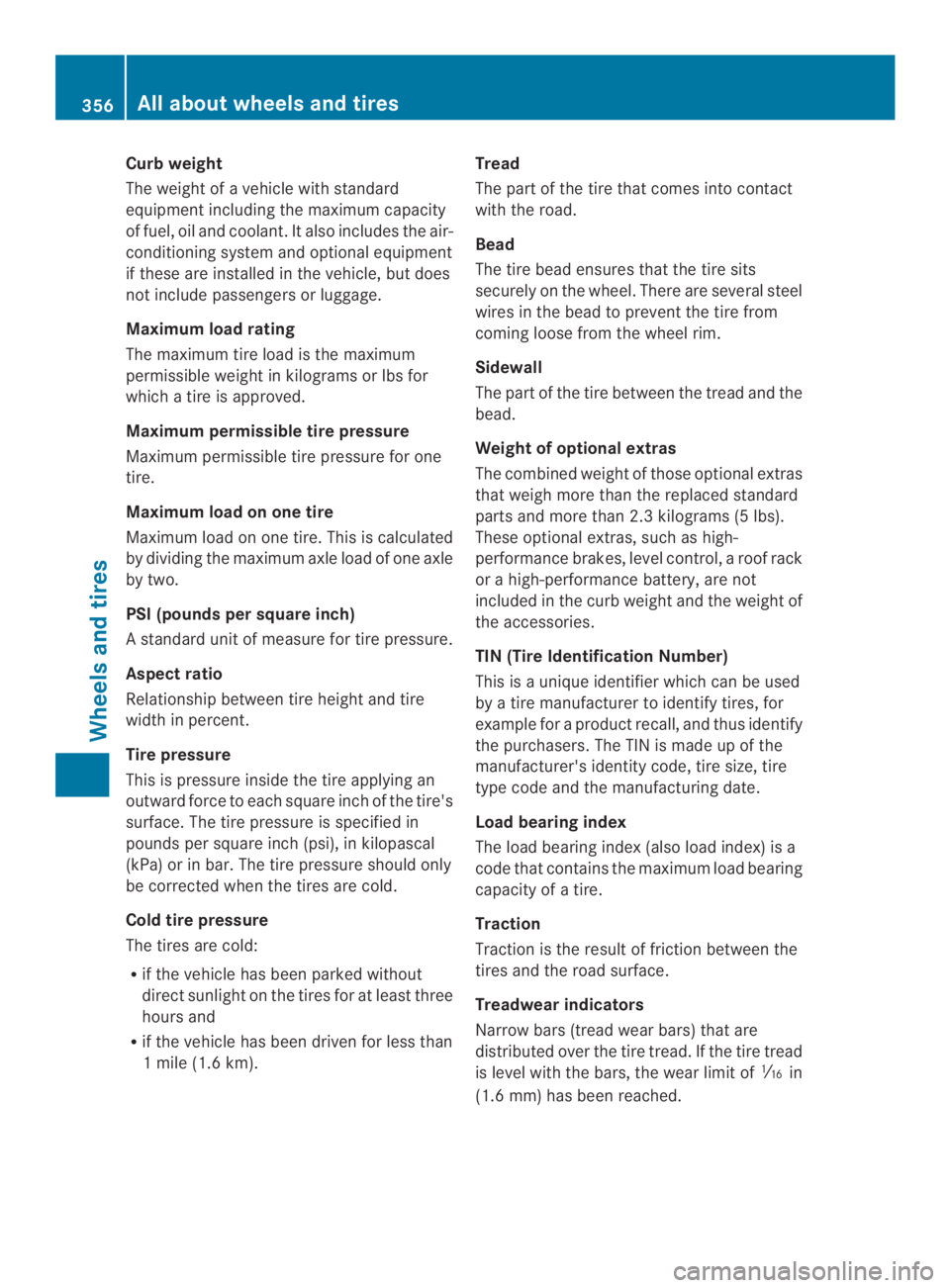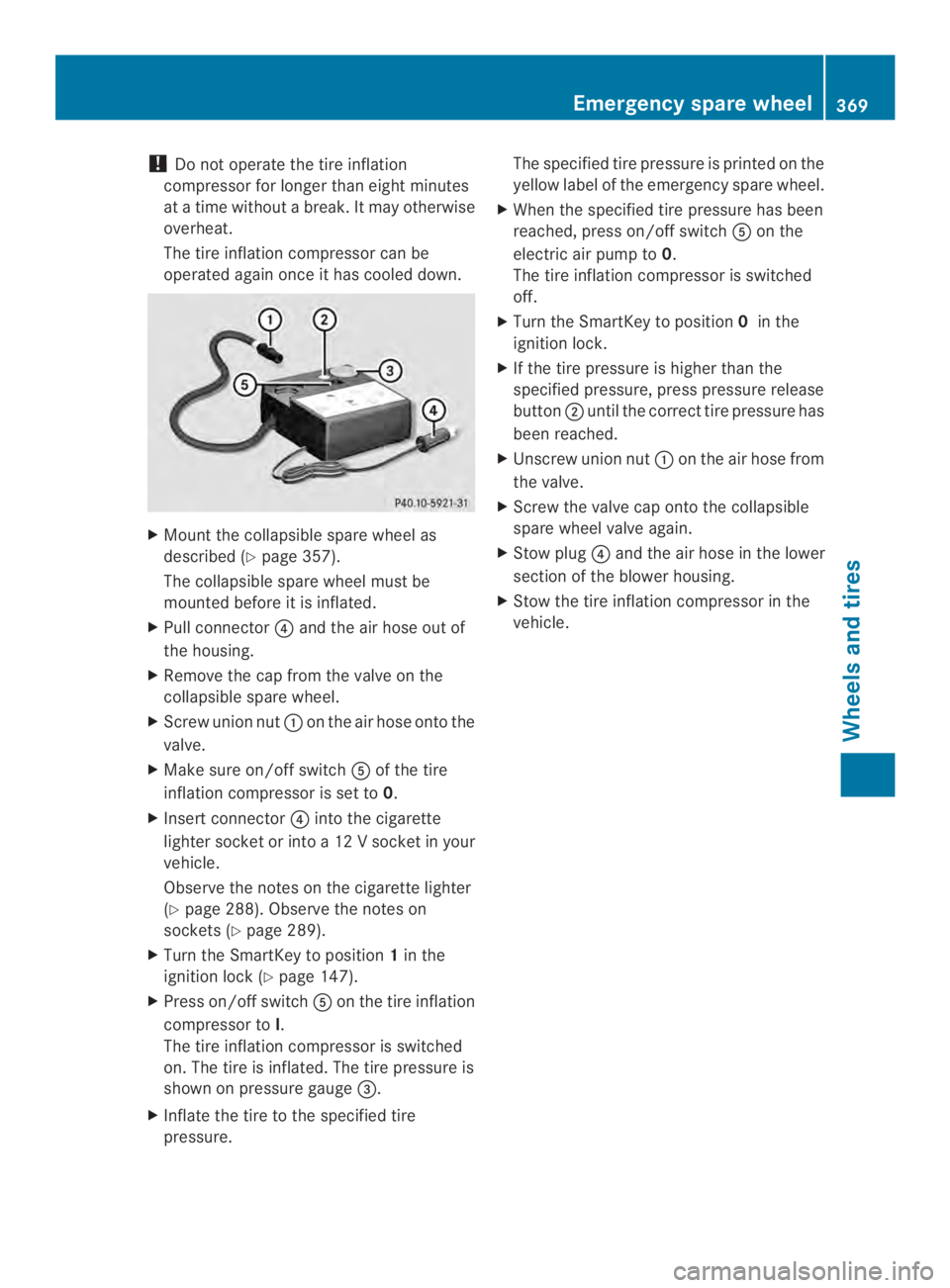Page 358 of 382

Curbweight
The weight ofavehicle with standard
equipment includingthemaximum capacity
of fuel, oil and coolant.Italso includes the air-
conditioningsystem and optional equipment
if these are installed in the vehicle, but does
not include passengers or luggage.
Maximumload rating
The maximum tireload is the maximum
permissible weight in kilograms or lbs for
whichatireisapproved.
Maximumpermissible tirepressure
Maximum permissible tirepressure for one
tire.
Maximumload on one tire
Maximum load on one tire. This is calculated
by dividingthe maximum axle load of one axle
by two.
PSI (pounds per squareinch)
Astandardunitofmeasure for tire pressure.
Aspect ratio
Relationship between tire height and tire
width in percent.
Tirepressure
This is pressure inside the tire applying an
outward forcetoeach square inch of the tire's
surface. The tire pressure is specified in
pounds per square inch (psi), in kilopascal
(kPa) or in bar. The tire pressure should only
be corrected when the tires are cold.
Cold tirepressure
The tires are cold:
Rif the vehicle has been parked without
direct sunlight on the tires for at least three
hours and
Rif the vehicle has been driven for less than
1mile (1.6 km).
Tread
The part of the tire that comes intocontact
with the road.
Bead
The tire bead ensures that the tire sits
securely on the wheel. There are several steel
wires in the bead to preventthe tire from
comingloose from the wheel rim.
Sidewall
The part of the tire between the tread and the
bead.
Weight of optional extras
The combined weight of those optional extras
that weigh more than the replaced standard
parts and more than 2.3 kilograms (5 lbs).
These optional extras, such as high-
performance brakes, level control,aroof rack
orahigh-performancebattery, are not
included in the curb weight and the weight of
the accessories.
TIN (Tire Identification Number)
This isaunique identifier which can be used
byatire manufacturer to identify tires, for
example foraproduct recall, and thus identify
the purchasers. The TIN is made up of the
manufacturer's identity code, tire size, tire
type code and the manufacturing date.
Load bearing index
The load bearing index (also load index) is a
code that contains the maximum load bearing
capacity ofatire.
Traction
Traction is the result of friction between the
tires and the road surface.
Treadwear indicators
Narrow bars (tread wear bars) that are
distributed over the tire tread. If the tire tread
is level with the bars, the wear limit of��in
(1.6 mm) has been reached.
356All about wheels and tires
Wheels and tires
Page 361 of 382

Securing the vehicle on slight downhillgradients
XOn light downhill gradients:place
chocks or othersuitableitemsinfront of
the wheelsofthe front and rearaxle.
Raisingthe vehicle
GWARNING
If youdonot positionthe jack correctly at the
appropriate jackingpoint of the vehicle, the
jack could tip over with the vehicle raised.
There isarisk of injury.
Only position the jack at the appropriate
jackingpoint of the vehicle. The base of the
jack must be positioned vertically, directly
under the jackingpoint of the vehicle.
!The jack is designed exclusively for
jackingupthe vehicle at the jackingpoints.
Otherwise, your vehicle could be damaged.
The following must be observed when raising
the vehicle:
Rto raise the vehicle, only use the vehicle-
specific jack that has been tested and
approved by Mercedes-Benz. If used
incorrectly, the jack could tip over with the
vehicle raised.
Rthe jack is designed only to raise and hold
the vehicle forashort time whileawheel
is being changed. It is not suited for
performing maintenancework under the
vehicle.
Ravoid changing the wheel on uphill and
downhill slopes.
Rbefore raising the vehicle, secure it from
rolling away by applying the parking brake
and insertingwheel chocks. Never
disengage the parking brake while the
vehicle is raised.
Rthe jack must be placed onafirm, flat and
non-slip surface. Onaloose surface, a
large, load-bearing underlay must be used.
Onaslippery surface,anon-slip underlay
must be used, e.g. rubber mats.
Rdo not use wooden blocks or similar
objectsasajack underlay.Otherwise, the
jackwill not be able to achieveits load-
bearingcapacity due to the restricted
height.
Rmakesure that the distancebetween the
underside of the tires and the grounddoes
not exceed 1.2in(3cm).
Rnever place your hands and feet under the
raised vehicle.
Rnever lie under the raised vehicle.
Rnever start the engine when the vehicle is
raised.
Rnever open or closeadoor or the trunk lid
when the vehicle is raised.
Rmakesure that no persons are present in
the vehicle when the vehicle is raised.
XUsinglug wrench��,loosen the boltson
the wheel you wish to change by about one
full turn. Do not unscrew the bolts
completely.
Changingawheel359
Wheels and tires
Z
Page 371 of 382

!Do not operate the tire inflation
compressor for longer than eight minutes
atatime withoutabreak. It may otherwise
overheat.
The tire inflation compressor can be
operated againonce it hascooleddown.
XMount the collapsiblespare wheelas
described (Ypage 357).
The collapsible spare wheel must be
mounted before it is inflated.
XPull connector�!and the air hose out of
the housing.
XRemove the cap from the valve on the
collapsible spare wheel.
XScrew union nut��on the air hose ontothe
valve.
XMake sure on/off switch��of the tire
inflation compressor is set to0.
XInsert connector�!intothe cigarette
lighter socket or intoa12Vsocket in your
vehicle.
Observe the notes on the cigarettelighter
(Ypage 288). Observe the notes on
sockets(Ypage 289).
XTurn the SmartKey to position1in the
ignition lock (Ypage 147).
XPress on/offswitch��on thetireinflation
compressor toI.
The tireinflationcompressor is switched
on. The tire is inflated. The tire pressure is
shown on pressure gauge�$.
XInflate the tire to the specified tire
pressure.
The specified tire pressure is printed on the
yellow label of the emergencyspare wheel.
XWhen the specified tire pressure has been
reached, press on/offswitch��on the
electric air pump to0.
The tireinflationcompressor is switched
off.
XTurn the SmartKey to position0in the
ignition lock.
XIf the tire pressure is higher than the
specified pressure, press pressure release
button��until the correcttire pressure has
been reached.
XUnscrew union nut��on the air hose from
the valve.
XScrew the valve cap ontothe collapsible
spare wheel valve again.
XStow plug�!and the air hose in the lower
section of the blower housing.
XStow the tire inflation compressor in the
vehicle.
Emergency sparewheel369
Wheels and tires
Z